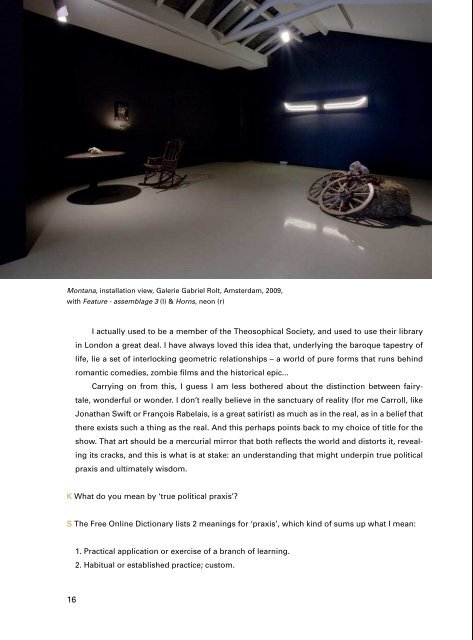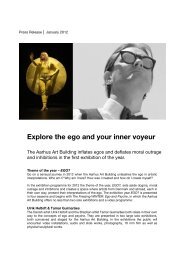eller - Århus Kunstbygning
eller - Århus Kunstbygning
eller - Århus Kunstbygning
You also want an ePaper? Increase the reach of your titles
YUMPU automatically turns print PDFs into web optimized ePapers that Google loves.
Montana, installation view, Galerie Gabriel Rolt, Amsterdam, 2009,<br />
with Feature - assemblage 3 (l) & Horns, neon (r)<br />
16<br />
I actually used to be a member of the Theosophical Society, and used to use their library<br />
in London a great deal. I have always loved this idea that, underlying the baroque tapestry of<br />
life, lie a set of interlocking geometric relationships – a world of pure forms that runs behind<br />
romantic comedies, zombie films and the historical epic...<br />
Carrying on from this, I guess I am less bothered about the distinction between fairy-<br />
tale, wonderful or wonder. I don’t really believe in the sanctuary of reality (for me Carroll, like<br />
Jonathan Swift or François Rabelais, is a great satirist) as much as in the real, as in a belief that<br />
there exists such a thing as the real. And this perhaps points back to my choice of title for the<br />
show. That art should be a mercurial mirror that both reflects the world and distorts it, reveal-<br />
ing its cracks, and this is what is at stake: an understanding that might underpin true political<br />
praxis and ultimately wisdom.<br />
K What do you mean by ‘true political praxis’?<br />
S The Free Online Dictionary lists 2 meanings for ‘praxis’, which kind of sums up what I mean:<br />
1. Practical application or exercise of a branch of learning.<br />
2. Habitual or established practice; custom.<br />
So by true political praxis, what I mean is a pragmatic application of politics as a methodology:<br />
i.e. utilizing an understanding of the structures that any context is contingent upon, to both<br />
deconstruct the given power-image relations in that context, and to embody the subversion of<br />
a given world-view or ‘established practice’ as a creative process rather than ‘in’ a responsive<br />
way. Rather than appropriating the sign of the political (a more emotive, superficial and less<br />
engaged form of approach).<br />
Equally it would be unfortunate to see a particular deconstruction or subversion as the<br />
goal in itself, as each movement runs the risk of becoming in turn habitual or ‘custom’. Perhaps<br />
this would account for my belief in nomadism, of medium, of place, of fetish – the danger is to<br />
put down roots, or to see from one view-point. Hence I prefer praxis to practice, it says some-<br />
thing about a kind of healthy detachment I try and cultivate.<br />
K I see. I was actually wondering more about the word ‘true’. I mean true indicates some kind of<br />
authenticity for me; but I guess in your case it is more about being true to the dynamics of the<br />
praxis?<br />
Talking about nomadism and dynamics, it is easy to see how avoiding fixation is important<br />
especially if one wants to alter anything in the current society of fixation, power and violence.<br />
However dealing with art, which in your case mimics popular culture and mythology, the work<br />
inevitably ends up rubbing against representation. In the end one can question whether it is<br />
possible at all to make art works and ultimately be true to dynamics.<br />
The philosopher and feminist theoretician Rosi Braidotti argues in her book Nomadic Sub-<br />
jects, as the title indicates, for the nomad as ‘a form of political resistance to hegemonic and<br />
exclusionary views of subjectivity’. 2 She advocates alternative representations by means of<br />
“mimetic repetition” (building on Luce Irigaray) – a textual and political strategy with the pur-<br />
pose of actively subverting established modes of representation and experiences (in Braidotti’s<br />
case of women).<br />
I wonder if this “mimetic repetition” applies to your work in Intensive Surfaces? I mean<br />
presuming you understand the signifier as something that must be consumed and reappraised<br />
from within?<br />
S I would say being true beyond the particular dynamics of the praxis, to a larger awareness<br />
of fiction as an evolving philosophical and political space. Something about creating not just<br />
one’s own reality, but a series of interlocking realities. So that contingency is both cause and<br />
effect. In this way rather than consuming the signifier and reappraising it, you are equally<br />
aware of the non-existence of the signifier, while utilizing it as a device to shake understanding<br />
from – almost like a child’s toy that is the signifier of a hammer, but even the ‘echt’ hammer is<br />
a signifier of itself (or of nothing).<br />
17



